 Home > CR Interviews
Home > CR Interviews CR Sunday Interview: Rich Tommaso
posted January 1, 2012
CR Sunday Interview: Rich Tommaso
posted January 1, 2012

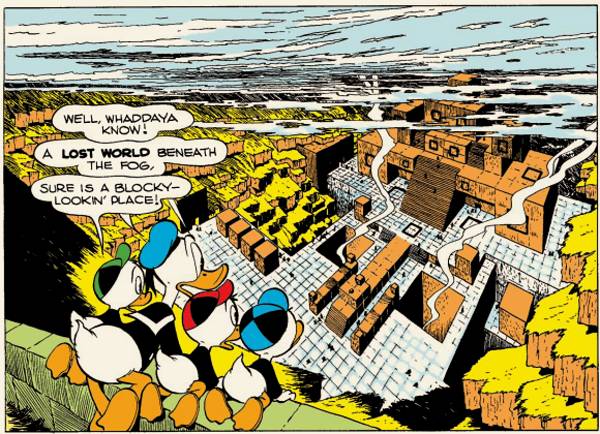
*****
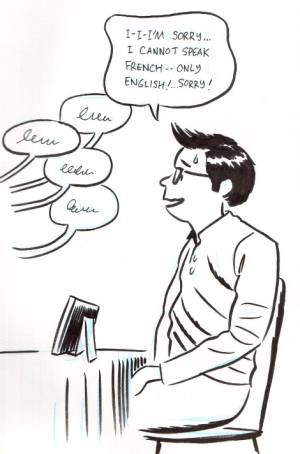
I've known
Rich Tommaso for about 15 years, since he wandered into Seattle as a way of pursuing his dream of making comics. He was coming off the stand-alone graphic novel
Clover Honey and the entertaining series from
Eros Comix Cannibal Porn; he'd soon start a series called
Rollercoaster, one of the many single-person anthology titles that dominated that decade of alt-comics. Tommaso was my then-roommate's work partner on the
Fantagraphics late shift, a job he describes in hilarious detail in a series of slightly melancholy comics detailing his time in Seattle (now sadly removed from his site) as a combination of hands-on art education and a lesson in how to adjust one's hours sheet to better reflect the money one should be making as opposed to the exact number of hours put in. He was good at his job. As I recall, Tommaso was doing a lot of coloring and color production work on the computer. It makes some sense, then, that when Fantagraphics was looking for a colorist for
its massive Barks Library project that Tommaso was one of Publisher
Gary Groth's phone calls. A first volume,
Lost In The Andes, is beginning to hit the North American market right now.
Tommaso has remained a productive, prolific cartoonist over the years, even when he hasn't had a North American publisher. His best-known work may be the Eisner-honored
Satchel Paige: Striking Out Jim Crow, which he did in conjunction with the cartoonist
James Sturm. Since
Alternative Comics went under a few years back leaving Tommaso in mid-series with
Miriam, the cartoonist has continued to work for French and Spanish publishers and in 2009 took himself on-line with
a good, old-fashioned, one-artist web site. He's simplified his style a bit, and currently works on multiple stories at once in part to keep himself motivated for the burst of work just ahead. Tommaso has always been a cartoonist for whom I've heard praise from his fellow cartoonists far more than from comics readers, and I think the work he's presently doing -- both for Disney and for himself -- deserves as wide an audience as possible. -- Tom Spurgeon
*****
TOM SPURGEON: Tell me how you got the Barks job. Was there a try-out? How were you contacted?
RICH TOMMASO: I was doing a few things for Fantagraphics, mostly lettering for their foreign books. Gary asked, "How are your coloring skills?" I said, "I'm doing well, doing my own stuff." He said, "Keep this under wraps." About a month later, he sent me about ten pages to do. I did those, and sent those in. They looked at them. And then Disney looked at them. Everybody seemed pretty happy with them.
SPURGEON: Do you have an inkling as to what exactly they liked about them? You're working from the original comics as a guide, but how much are you moving away from them? How closely are you adhering to the comics?
TOMMASO: The big thing is they wanted muted colors. I don't have the book in front of me, but they didn't want it too loud. They didn't want computer effects and stuff like that. They wanted it simple. So basically that's what I did. I would look at original comics on-line and I had a bunch of original
Uncle Scrooge comics at home. So what I was really trying to do was not trying to be like, "This should be 100 percent blue or red." I was trying to find a muted version of that color.
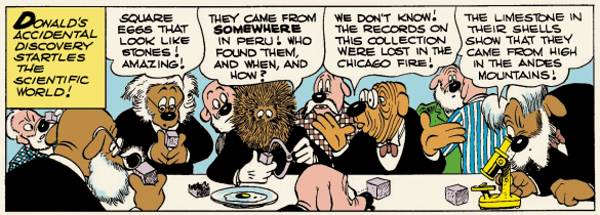 SPURGEON: Is there a reason they wouldn't just shoot from the original comics like a lot of people do now? Is there something you get from re-coloring it this way?
SPURGEON: Is there a reason they wouldn't just shoot from the original comics like a lot of people do now? Is there something you get from re-coloring it this way?
TOMMASO: I had asked them about that. When we were going over the coloring, we were going into what they were looking for, for instance if they were going to shoot it on yellow paper. I said, "Are you going for a
Dark Horse thing, like with the
Little Lulus, or are you going for what
Drawn and Quarterly does, where they scan the original comics?" They claimed they wanted to go somewhere in-between that. They're trying to get as big of an audience as they can for this stuff. They want the younger generation, and they also want the collectors. I think with
the John Stanley library at Drawn and Quarterly, while there are kids that get into that, too, I think they thought of that as being for collectors, people that know the material well. For this they wanted something in-between: they didn't want to repeat what companies had been doing in the recent past, and they didn't want to just scan the original pages. They were worried about what the younger generations would think of that.
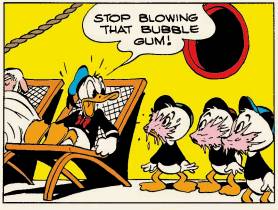 SPURGEON: As a cartoonist yourself, and as someone who works with color, you've lived with these comics for a while now and will continue to do so for some time to come. What do you think of the coloring? It's not like your coloring, not really. Do you see the strengths to that approach? Do you see things about how this work is colored that you might have missed just powering through the comics as a reader?
SPURGEON: As a cartoonist yourself, and as someone who works with color, you've lived with these comics for a while now and will continue to do so for some time to come. What do you think of the coloring? It's not like your coloring, not really. Do you see the strengths to that approach? Do you see things about how this work is colored that you might have missed just powering through the comics as a reader?
TOMMASO: When I started doing it, I forget what the story was I started on, but I started on an
Uncle Scrooge story. And a lot of things seemed like really odd choices [laughs] for coloring. Trees that are green, and things like that. These are really odd. I would never choose colors for some of the stuff in the background. Disney was also talking to
Kim [Thompson] and Gary about it. They said we didn't have to be so religious about it. They wanted to make sure the color for the ducks, the reds and blues and the yellows, that those were pretty much bang-on. But they agreed that there was a little bit of leeway. If something looked like a bad color choice, you could find something in the ballpark range of that color. So that's what I would do. "What's something that's a little more aesthetically pleasing than the color I'm looking at for this building, this road or this tree?" So I don't follow them too religiously if the colors are kind of odd. Because sometimes they are strange color choices. Colors that don't really complement. Some completely clash. I would find something in the ballpark range that looked a little better.
 SPURGEON: Are you learning about color by going through this process? Is there a value to these simple colors? When the colors pop off the page in these comics, they really pop -- the characters are mostly white, which helps. The spot colors really stand out. Is there something you might take back to your own work?
SPURGEON: Are you learning about color by going through this process? Is there a value to these simple colors? When the colors pop off the page in these comics, they really pop -- the characters are mostly white, which helps. The spot colors really stand out. Is there something you might take back to your own work?
TOMMASO: I think as far as traditional colors, I'm always afraid to use red and blue and yellow, that kind of thing. I always think that I can find some more interesting shade of blue I can use. It
has changed the way I think about that, because when I look at it on screen I'm like, "That works." I would never think of doing 100 percent blue right there in that panel, but when I look at it I notice that it looks good to have a duck with an orange color, or a red shirt against a yellow background. I do pick up on things like that. Now when I color my own stuff I won't be so crazy about wanting to not put a normal yellow in there, wanting to put something different. Now when I see something that doesn't work, it comes from working on this stuff, noticing how well basic colors work sometimes.
SPURGEON: Do you have a history with Carl Barks?
TOMMASO: Yeah. As a kid I read a lot of Barks. I'm sure I've read a lot of
Don Rosa, too, I'm not sure I could distinguish them back then. I re-read Barks in my twenties, got back into him.
SPURGEON: Has spending time with these comics that way been enlightening at all, in terms of seeing what Barks did and how he did it? I wonder if of all the great cartoonists people don't have a shallow or even warped appreciation of Barks. They like him, but they're not sure exactly why. That's why the longer stories might be more valued than the shorter ones, for example, even though the shorter ones can be exquisite.
TOMMASO: I always forget how interesting his stories are. I was working on one story with a really great ending to it, one that wasn't so obvious. It was something that alluded to a joke earlier in the story. I thought it was so great that it ends like that, because
I get it, but today they'd say that if little kids would read it they might not pick up on that so maybe they should draw it out a little more. Things like that. He really was a good writer for that stuff.
I revisited Barks in my twenties because I was looking to get a simpler look to my work. I remember reading
Alex Toth saying that a measure of a good artist is that he can make a great drawing in five lines rather than a million lines. That made so much sense to me. So reading Barks I totally picked that up. Looking at him before coloring him, I could see in the work how amazing he could draw. He can draw something with five or six lines that looks beautiful. Or he can draw two objects in a panel, and you'd think that you need more in a panel, but it's completely balanced and looks great. I appreciate him.
 SPURGEON: How much of the production are you doing? Are you indicating the color, or are you doing the computer files that go off to the printer?
SPURGEON: How much of the production are you doing? Are you indicating the color, or are you doing the computer files that go off to the printer?
TOMMASO: They send me all the files digitally. I sit down and color them all. One thing I do is that with the reds, yellows and blues, when I see something that's supposed to be 100 percent of those colors, I just put in 100 percent cyan or yellow or magenta. Those they assign pantone colors. We couldn't find those three colors in a CMYK mixture that was really, really vibrant. The pantone colors are much richer colors. They handle that. I color everything on one layer, and they use that. As far as production, I don't handle that. I basically just color them and save them and send them back.
SPURGEON: How big a gig is this? Do you know how long you'll be doing this?
TOMMASO: I might be doing this for 15 years. [laughter] It's pretty much that long of a thing. It's something I do five days a week. I do it on Monday through Friday at the beginning of each morning. It's about six hours to eight hours a day. And then the rest of the day is doing my own work. So every morning I work on three pages of it. Five days a week. It's basically my job. [laughs]
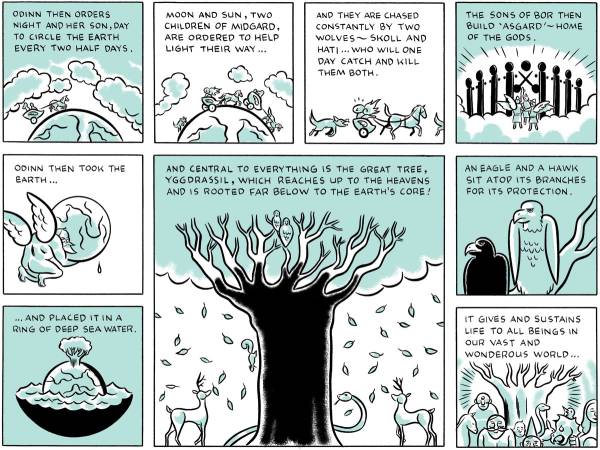 SPURGEON: That's a handy transition into your own work. You've been very prolific the last few years. It seems like you've given yourself some leeway to bounce around to the stories that interest you, but your overall production seems high. Has that been easier for you as you've become older, to get in and focus on the work that way?
SPURGEON: That's a handy transition into your own work. You've been very prolific the last few years. It seems like you've given yourself some leeway to bounce around to the stories that interest you, but your overall production seems high. Has that been easier for you as you've become older, to get in and focus on the work that way?
TOMMASO: It has been getting easier. For about 15 years I've wanted to do more than one story. It's kind of surprising that I'm working on four or five at a time. I keep thinking that a few years ago this wouldn't have worked, but I'm able to do it all of the sudden. I think with doing the web site, because I know I have to post five days a week, that keeps me working. A lot of the stories, I'm doing a page they day before they're posted. They have to be drawn and then colored either that night or the next morning. I think because of that, because I know it has to be posted the next day, I'm able to keep it going. I don't know why something suddenly clicked, and I'm able to work on all of this stuff.
 SPURGEON: Does the variety help? Does being able to move from story to story, has that been helpful?
SPURGEON: Does the variety help? Does being able to move from story to story, has that been helpful?
TOMMASO: It's been very helpful. I've always had a hard time working on the same thing for very long. I have terrible ADD when it comes to working on comics. That I can work on something that I didn't work on yesterday, this kind of keeps it exciting. Each day I can work on something completely different.
SPURGEON: What was the initial impetus to go on-line with so much of your work? And why the choice of a personal web site as opposed to taking it to someone or joining a collective? What put you on that self-directed web site path?
TOMMASO: I think it was just a way to help me work and get some kind of feedback. My girlfriend Amy suggested it. She was like, "You should put your stuff on-line. Then you can color it and see it in color, and you can work on it that way. At least you'd be getting feedback on it." That was basically the thing. I was having trouble getting my comics through a publisher. When Alternative folded, I had nowhere to go with
Miriam. I did have a contract with a company in France to work on a 100 page or more volume of it. I thought I could work on that book, and put it on-line, and do the coloring, and tell people about it and get some feedback. That really helps. It's really hard for me to work in a vacuum for too long.
SPURGEON: Do you have a sense of who's reading your site? I know you have a lot of fans among cartoonists; that's who I hear talking about your work. Are the site readers other cartoonists? Are they long-time Tommaso fans? Are they people interested in the subject matter? Do you have a sense of who sees it when you put it up on-line?
TOMMASO: It seems like a lot of people get in touch with me through Facebook. It seems to me like a lot of new readers, people I don't know. Some people know the work, but others people hear about it somewhere and start reading it. It seems like a little bit of both. I do have cartoonist friends that visit.
SPURGEON: Are you happy with the way that your visuals have been pared down in a lot of your more recent work. It seems like your work has a greater simplicity to it now, at least in most of the stuff that's on-line. Are you happy with the way that your work has progressed in terms of its overall look?
TOMMASO: That's something I struggled with for about ten years. I have a really hard time working on long projects. I knew that a lot of cartoonists simplified their drawing styles, and thought maybe that would help. I tried doing that, but was always really unhappy with the result. But I'm really happy with what it's looking like now. I draw almost to size, pretty small, using pen and ink. I never thought I would like it as much as the stuff I did with a brush, much larger. I look at some of the stuff side by side, and the quality seems almost equal to me. I finally found that balance where I'm drawing much simpler, but it's not too simple. I was going a little bit too simple, and it wasn't interesting to me to work on a whole book that way. But the way I'm working now, I'm actually happy with it.
SPURGEON: You wrote something super-recently about Sam Hill that even with this kind of day-to-day approach, and the simpler visual, that the narrative got away from you a little bit. The first book ended up longer than you thought it would. Is that something you're still working on, how long to make your narratives, how you're pacing them? Or is that something that's evolving organically, that you're just making pages, and it'll be the length it will be.
TOMMASO: That's basically the idea, yeah. Some comics are fully scripted out. The
Dry County comic that's up there, that was something I full scripted out. That's the first time I've done that in a long time. For that book it was easier to do that way.
Sam Hill is also an introductory book, so I wanted to make sure I had enough room to tell you about the characters, give some of their history. So yeah, I go into a project like that not knowing how long it will be, seeing how it goes, writing it day by day.
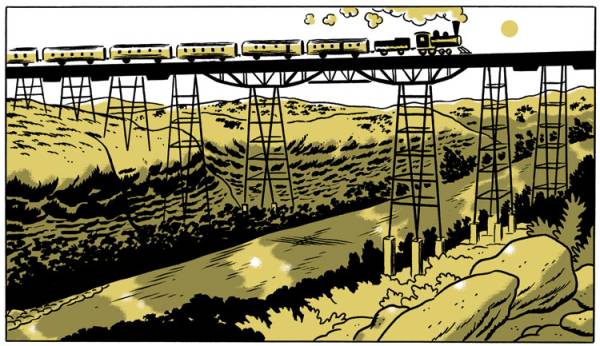 SPURGEON: I'm enamored of that one of all your current projects. I wondered where that setting came from, 1920s Texas. It has a bit of a drifter's story quality to it, and it's not really a western as we understand them.
SPURGEON: I'm enamored of that one of all your current projects. I wondered where that setting came from, 1920s Texas. It has a bit of a drifter's story quality to it, and it's not really a western as we understand them.
TOMMASO: I've always wanted to do a series -- it was always called
Sam Hill -- based on the life and works of
Jim Thompson. I wanted to maybe do something historical. I feel like I have to have a personal connection to the work. I was reading a biography of Thompson. He grew up in West Texas, in pretty much the same area that my
Sam Hill story is set in. Reading about his relationship with his father and the generation gap that existed, it eerily mirrored my relationship with my father. It was a different time period, and a different culture, but it was so similar. I thought that was at least a jumping-off point, that I could relate to those kinds of characters that way. That's what kicked it off. I have many books planned for the series. I want to do as many as I can. I have notes for about 12 books, although I don't know how many I can get to. It seemed like a good place to start: a crime series with a great deal of American history. Texas in the 1920s. When I read that biography, that made me think I could do this.
 SPURGEON: Is there additional historical research grounding
SPURGEON: Is there additional historical research grounding Sam Hill
, or are these more your impressions of that time and place?
TOMMASO: I actually didn't know how long the book was going to be. I had all these plans -- I didn't know if it was going to be huge or small. When I was thinking of a longer version, going through about four or five years of his life, I started reading everything I could about the 1920s. I've been reading books on the flapper generation, and novels published during that time:
Fitzgerald's novels, and
the oil novels of Upton Sinclair. I've been reading as much as I can about the time period, regardless of how much that would actually go into the book itself. I've been doing a lot of research, trying to avoid any mistakes. [laughs]
SPURGEON: A lot of your on-line work is distinguished by an approach to color... a couple of the comics have more than one color, but for the most part the overall look to your work now is based on the use of a single color. Why do your comics look like that now?
TOMMASO: The thing with me -- which is funny because now I'm coloring
Donald Duck, which is four-color -- is that I was always afraid of using four-color. I could never make that shift from doing something manually with paint to the computer. It seemed like I was always choosing colors that weren't appropriate. I think using one tone not only am I not going crazy trying to figure out which colors are appropriate for what I'm doing, I can think of them more as shading than color.
The Yearling is in full color, but that's the first time I've braved something like that. I think it's because I'm doing the
Donald Duck comics that I felt I could do that now. But yeah, using the one-color for most of those comics is because I wasn't very good at using more colors on the computer, choosing colors. So I think working on
Donald Duck has really helped. There are so many times when I wouldn't think of using certain colors, and
Donald Duck has really helped out. With
Sam Hill and
Vikings' End, I thought of color as
Zip-A-Tone, almost. I've since become more confident with more colors.
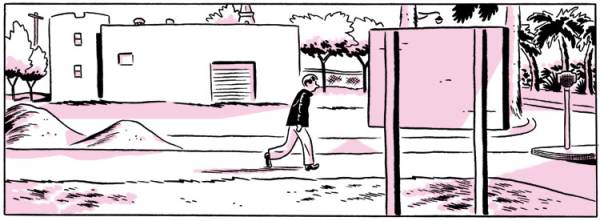 SPURGEON: Does the individual color you select matter? With
SPURGEON: Does the individual color you select matter? With Dry County
, for instance, the single color employed is a pink. Why that color?
TOMMASO: It's set in Miami. It complements the story so well, because there are sunsets -- I thought it would work in that way. I thought it would help with the crime scenes as well. With
Sam Hill the color seemed appropriate to the time period and the setting.
SPURGEON: Are you looking towards eventual book collections on these serials? How far along are those plans?
TOMMASO: The
Sam Hill book, I started it in the Fall of 2009, and I'm just wrapping it up now. It should be done in a month. I have like 18 pages left to go. I don't have a US publisher! I have a French and a Spanish publisher. I have contracts ready for
La Capúla and
Çà et Là to publish it.
SPURGEON: In a way, this makes you perfect for the duck comics, that you have more traction in Europe than here.
TOMMASO: Yeah, I know, it's funny. [laughter]
Peter et Miriam, I kept working on it because I had this contract in France but no one was biting on it here. I went to
Angouleme last year and it was amazing how many people came up to me and talked to me about the book. They wanted to know when a second one would be out. There was a lot of excitement for it.
SPURGEON: I haven't talked to anyone that was at Alternative when it faded from existence. Was that tough? Was everything communicated to you in a decent fashion, was it an okay transition out? Or was it messy the way those things can be?
TOMMASO: It was tough in the way that I had a second issue of
Miriam ready to go. Because Alternative had an exclusive contract with Diamond, I was told it would be fine, I wouldn't have to make it into a graphic novel. That's just when they were starting to drop a lot of floppies based on sales. I think a month later I called
Jeff [Mason] up and he said he was going to stop publishing. That was really hard, because it was tough to take this floppy comic series to anyone else. Everybody was getting away from that, and I'd only put out one issue, so it hadn't gained any market traction.
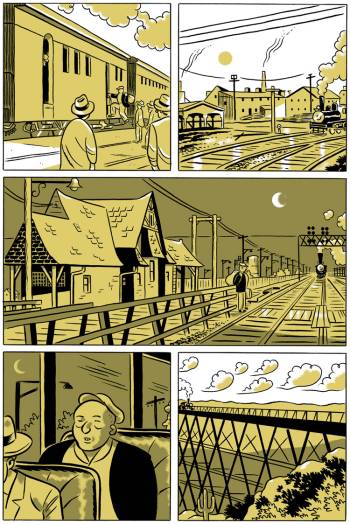 SPURGEON: I think you're still under-read by comics folks. It took me a while to find your site, and you've stayed at my place before. I think you had to pester me directly.
SPURGEON: I think you're still under-read by comics folks. It took me a while to find your site, and you've stayed at my place before. I think you had to pester me directly.
TOMMASO: [laughs] Probably, yeah.
SPURGEON: Should people just visit your site frequently or semi-frequently? Should they friend you on Facebook?
TOMMASO: I think the most people come to me from Facebook. I get a lot of people there, a lot of artists on there particularly. As far as the site itself, most people go there to read
Sam Hill. Maybe because there's more of it there than anything else.
SPURGEON: It's a good chunk of material, that's for sure. Hey, here's something I wondered. It seems like you use a more simple grid these days: a six-panel page or a three-panel one, even. Any special flourishes are kept to a minimum. Are you simplifying in a narrative sense as well as with the visuals?
TOMMASO: I am, yeah. I think for the most part I've been using the six-panel grid for things. I was always trying to do crazy layouts, or more interesting layouts, and it slowed me down. I would re-read things, and think, "This isn't really working." Trying to focus on visually interesting layouts could even distract me from the story. Keeping to the six-panel layout makes it easier to write.
This was the other reason I was simplifying my art. I'd spend so much time on the drawing my mind would get away from the writing. I think of
Love and Rockets as a prime example. It doesn't matter how many panels they use. It's the drawings inside them that matter.
*****
*
Rich Tommaso's Web Of Comics
*
Lost In The Andes, Carl Barks, Fantagraphics, hardcover, 240 pages, 9781606994740, Fall 2011, $24.99.
*****
* panel from
Lost In The Andes
* self-portrait in a sketch
* four panels from
Lost In The Andes
* image from
Vikings' End
* image from
Yearling
* two images from
Sam Hill
* an image from
Dry County
* page design from
Sam Hill
* one more image from
Sam Hill (below)
*****

*****
*****


